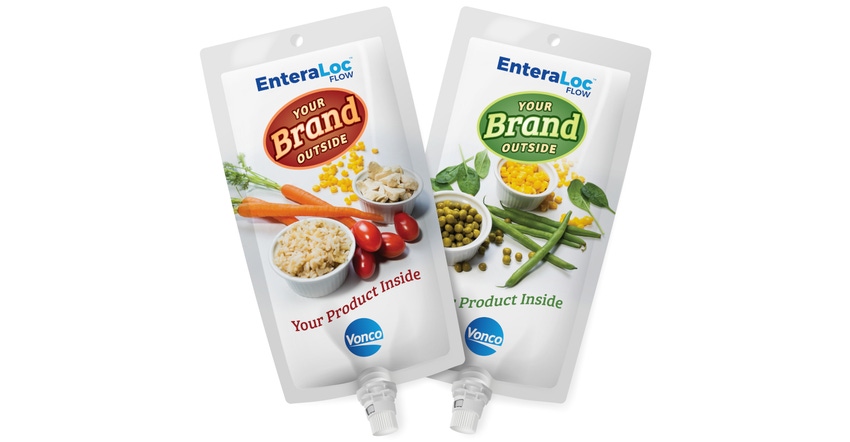FDA Approves OTC Designation for Enteral Feeding System
Available by prescription since 2021, EnteraLoc Flow is hailed as the first closed-loop feeding system for enteral patients.

Every year, more than one million patients in the United States are placed on feeding tubes to sustain life and improve healing. With FDA’s recent approval of EnteraLoc Flow as an over-the-counter (OTC) enteral feeding system, patients and caregivers will now have greater flexibility to purchase nutrients as needed without waiting for a prescription.
Contract manufacturer Vonco Products designed the medical packaging solution, which consists of a flexible pouch, a leak-proof seal, a custom-designed spout, and a direct-connect ENFit device. Vonco’s president Keith Smith recently answered Packaging Digest’s questions about the product’s OTC status and the benefits of EnteraLoc Flow over traditional enteral feeding systems.
How will this product enhance the lives of enterally fed individuals and their caregivers?
Smith: EnteraLoc Flow delivers nutrition directly into the patient’s feeding tube — no mixing, blending, or transferring from syringe to tube. It’s designed to improve the nutrition and hydration of tube-fed patients by providing a convenient method of nutrient delivery that is simple and safe with no mess and can be consumed on-the-go or in the hospital, long-term care facility, rehab facility, or homecare setting.
Clinical studies show that patients are administered less than 50% of prescribed protein due to the time it takes care providers to prepare and deliver these products. The American Society for Parenteral and Enteral Nutrition (ASPEN) states that meeting these goals can reduce in-patient mortality, risk of infection, and time to discharge while preserving lean muscle mass. EnteraLoc Flow enables private labeled brands, like Banatrol, to meet ASPEN guidelines for fiber and diarrhea intervention and can reduce the incidence of tube-fed diarrhea and improve gut health.
How does this package simplify food delivery, reduce mess, and promote on-the-go consumption?
Smith: EnteraLoc Flow introduces a novel way to administer nutrients, including liquid protein and fiber modulars, through a feeding tube. Typically, nutritional formulas come in large, bulky, rigid plastic bottles or cartons and require multiple messy steps for caregivers to administer. With EnteraLoc Flow, nurses and caregivers no longer have to mix, stir, and syringe modular nutrients down the feeding tube, which can cause clogging or occluded tubes if the nutrient is not properly mixed or thin enough.
Some patients continue to use hospital-grade feeding sets or pumps in the home due to the lack of feeding solutions and methods of delivery. This requires they be at the home for every feeding, which severely limits their mobility. Because EnteraLoc Flow comes prepackaged with nutritious formulas, patients can simply connect the pouch to an ENFit device and consume anywhere. They simply squeeze the pouch to administer the nutrients.
Because EnteraLoc Flow comes prepackaged with nutritious formulas, patients can simply connect the pouch to an ENFit device and consume anywhere. They simply squeeze the pouch to administer the nutrients.
Can you share the results of the human factors study that was conducted to obtain OTC clearance?
Smith: The EnteraLoc Flow Human Factors Study was largely directed to a random selection of laypersons with no clinical background. The breakdown of participants was 83% non-clinical and 17% clinical. No participants had experience with enteral feeding.
Following the provided instructions, all participants were asked to complete five simulated tasks, answer seven knowledge-based questions, and provide user feedback.
The following results were recorded as part of the study: 100% of simulated tasks were completed properly; 99% of participants correctly answered 100% of all questions in the survey; no lay users scored the use of EnteraLoc Flow as “not at all easy to follow;” and the average score for “how easy is EnteraLoc Flow to use” was 4.6 out of 5, with 4 being “very easy” and 5 being “extremely easy.”
What other options do people have for being enterally fed? How does this compare to those options?
Smith: When patients have trouble with eating or digestion, some are required to adopt a nutrition therapy that delivers liquid formula or blenderized food directly to the gastrointestinal tract via a feeding tube inserted into the stomach. When prescribed at home, this treatment is called home enteral nutrition (HEN). HEN seeks to help patients meet daily caloric requirements by sourcing specially formulated meals that provide the right balance of nutrients.
Bolus tube feedings are commonly administered with repeated use of a disposable 60 milliliter syringe to administer approximately 1,500 to 2,000 mL of nutrients. This varies based on nutritional content and patient requirements. This syringe feeding can require 25 to 35 uses per day. The patient and/or caretakers learn to administer feedings, care for and maintain the enteral tube, and understand the equipment and associated devices involved, including a complex, clinically designed enteral feeding pump with the associated devices.
Bolus feeding is not practical for many enteral patients. It is time-consuming, can be aspirated more easily resulting in concerns for patient safety, and is often not well tolerated. Moreover, patients and caregivers are responsible for sourcing and arranging delivery of enteral nutrition formula and related supplies from their dealer or home infusion company with a physician’s prescription.
Unfortunately, existing enteral devices and delivery systems are not tailored to the needs of the individual patient. Most are overly complex, difficult to administer, create unnecessary messes, and can be wasteful. This can result in inadequate nutrient intake. And formulations may provide insufficient nutrition due to the difficulty to infuse into the patient or poor nutritional content. Additionally, they are not easily tolerated and require multiple steps to administer. Common patient complaints include weight loss, bloating, diarrhea, nausea, vomiting, reflux, abdominal pain, low energy, and frustration at the inefficient feeding process.
HEN patients are demanding an enteral feeding solution designed for them vs. the acute care setting or clinician.

The prescription version EnteraLoc Flow spouted pouch with ENFit connector was developed with insight from patients, clinicians, and brand owners. What specific features did they ask for?
Smith: Vonco executed a targeted user study to determine the features and benefits that enteral patients cared most about in regard to their daily feeding routine. Here are the patient-preference results, starting with the most important: less mess, independence, easy and simple to use, better nutrition, store unused food/portion control, food flow at my chosen rate/less time, eat real food, and must be reimbursed or affordable.
What customers do you have for the OTC format, and when will those products appear on store shelves?
Smith: EnteraLoc Flow is a contract-manufactured solution that can be filled and sold directly to patients by a nutrition formulary. Currently, EnteraLoc Flow can be purchased from Medtrition under the brand names Banatrol TF and ProSource TF20.
Vonco is working with several leading brands and building partnerships with additional nutritional formularies to bring the EnteraLoc Flow system to the broader enteral community.

Where will the OTC packages be sold?
Smith: We are actively working with partners on the release of EnteraLoc Flow as an OTC option. We estimate the OTC version will be available via online retail by late 2023. In the meantime, the product will remain in readily available supply through the current access channels.
Kassandra Kania is a freelance writer based in Charlotte, NC. She has written extensively about healthcare packaging for a variety of publications.
About the Author(s)
You May Also Like




